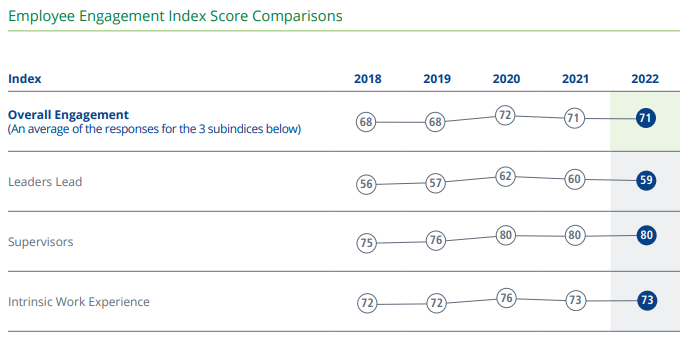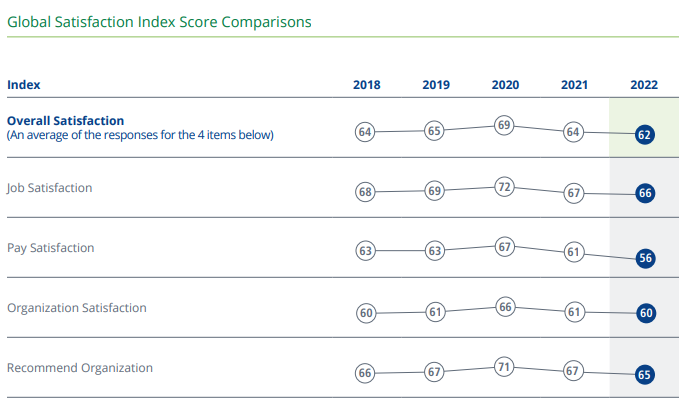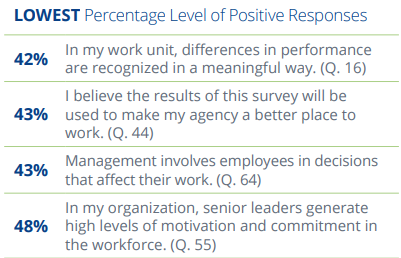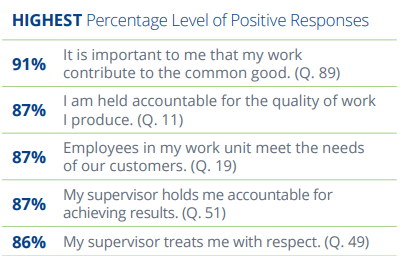
Agencies’ transition to hybrid work shows through in 2022 FEVS results
About one quarter of 2022 FEVS respondents said they'd consider leaving their position based on their agency's current telework or remote work options.
Best listening experience is on Chrome, Firefox or Safari. Subscribe to Federal Drive’s daily audio interviews on Apple Podcasts or PodcastOne.
Although employee engagement steadied in the 2022 Federal Employee Viewpoint Survey (FEVS), details of the survey’s results revealed where federal employees may be looking for more workforce improvements.
One of those areas looked at how employees felt about their agencies’ telework policies. About three-quarters of FEVS respondents said they wouldn’t consider leaving their position based on their current telework or remote work options.
But that left about a quarter overall who said they would think about leaving. Of that amount, 11% said they’d consider switching to a position at another agency that offered more telework flexibility. Still others said they would consider leaving for the private sector, or even another position within their current agency.

At the same time, 74% of respondents said they felt that senior leaders supported policies and procedures that protected employees’ health and safety.
“This year, the timing of the 2022 survey coincided with many employees increasing their in-person work at their agency worksites, while also navigating transitions to hybrid workplaces and work arrangements,” the Office of Personnel Management, which administers the survey each year, said in the FEVS governmentwide management report, published on Nov. 30.
This year, OPM modified questions about telework in the 2022 iteration, to incorporate more context about remote work and changing factors in the post-pandemic work environment. Much of employees’ perceptions, though, boiled down to how their supervisors and leaders handled changes in the workplace.
“As the federal workforce navigated changes in their work arrangements, support from supervisors on health and safety and promoting a positive work environment were important factors during this period,” OPM Director Kiran Ahuja said in the report.
According to the latest version of FEVS, 17% of respondents said they telework one to two days per week, compared with 10% in 2021. And 25% said they now telework three days per week, though OPM did not have comparative data from last year for that question. At the same time, 14% said they work remotely, while 20% said they don’t telework because their job requires them to be onsite. Just 4% said they don’t telework because they choose not to.
Other recent federal employee evaluations showed similar trends about feds’ perceptions of telework policies. An exclusive online survey from Federal News Network, for instance, found that about 64% of survey respondents said they were satisfied with their current work situation. But more than 75% said returning to the office on a regular basis would be concerning.
Additionally, in the three rounds of governmentwide pulse surveys from earlier this year, many respondents said they would take a job elsewhere if it offered more workplace flexibilities and remote work options. OPM Director Kiran Ahuja has also spoken up on the topic, too, warning agencies that more rigid telework policies may lead to higher staff attrition.
Despite some shifts in employees’ views on telework, overall employee engagement steadied in the 2022 FEVS, remaining at 71% between 2021 and 2022. The index measures how employees feel about agency leaders and supervisors, as well as their intrinsic work experience.

Within that index, perceptions of senior leadership had the lowest scores, at 59%, while supervisors had much higher scores of 80%. It’s a common trend each year in FEVS, with immediate supervisors garnering more positive perceptions from survey respondents.
Another index on global satisfaction showed a 2% decrease, from 64% in 2021 to 62% in 2022. The global satisfaction index considers job, pay and organization satisfaction, as well as whether respondents would recommend their agency as a good place to work.

Pay satisfaction in particular saw the largest decrease in the global satisfaction index, declining from 61% last year, now down to 56%.
“Results could reflect changes in the context when living costs rose without a corresponding increase in pay for most employees,” OPM said.
Several questions also showed more negative feedback from some FEVS respondents.
“Some of our lowest scores included dissatisfaction with lack of recognition for a job well done, including recognizing differences in performance, and employees not being involved in decisions that impact their work. We also scored relatively low on using the results of this survey to make our agencies better places to work,” Ahuja said.

Some of the highest-scoring questions related to positive perceptions of agency supervisors, as well as contributions to agency customers and the common good.
“Positive perceptions of agency supervisors were a strong influence on such optimistic performance assessments, captured by the high scores (80%) on employee evaluations of supervisors in the employee engagement index. Showcasing the widespread spirit of public service in the workforce, an overwhelming number of respondents (91%) agreed it was important to them that their work contribute to the common good,” Ahuja said.

Additionally, a brand new index measuring perceptions of diversity, equity, inclusion and accessibility showed that 69% of 2022 FEVS respondents reported positive perceptions of their agency’s DEIA-related practices.
Breaking down the data on DEIA, the results showed that smaller agencies generally fared better. In particular, larger agencies scored as much as 10% lower than small agencies specifically for their agency’s accessibility practices. Diversity had the smallest disparity between very small and very large agencies, with larger agencies trailing by 5%.
“Going forward, the addition of survey content will allow leadership to track diversity, equity, inclusion and accessibility in agencies and across the federal government, as well as resilience, innovation and other responsive future work topic areas,” OPM said.
Overall, OPM said the data from FEVS each year informs policy and provides governmentwide metrics, tracking progress on topics such as veteran’s employment experience and the future of work.
The 2022 FEVS also marked two decades of OPM distributing the survey, as well as a return to the traditional timeframe of FEVS, after delaying the survey for two years during the COVID-19 pandemic. OPM sent out the survey to employees in the spring and published the results in the fall. OPM published the 2021 FEVS results in April this year.
Copyright © 2025 Federal News Network. All rights reserved. This website is not intended for users located within the European Economic Area.
Drew Friedman is a workforce, pay and benefits reporter for Federal News Network.
Follow @dfriedmanWFED





